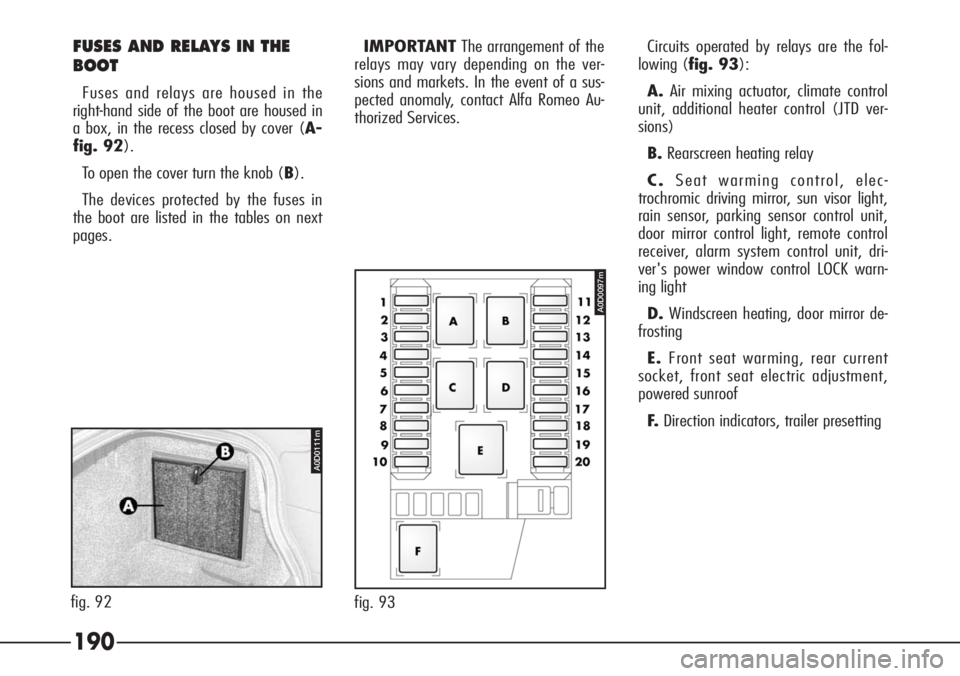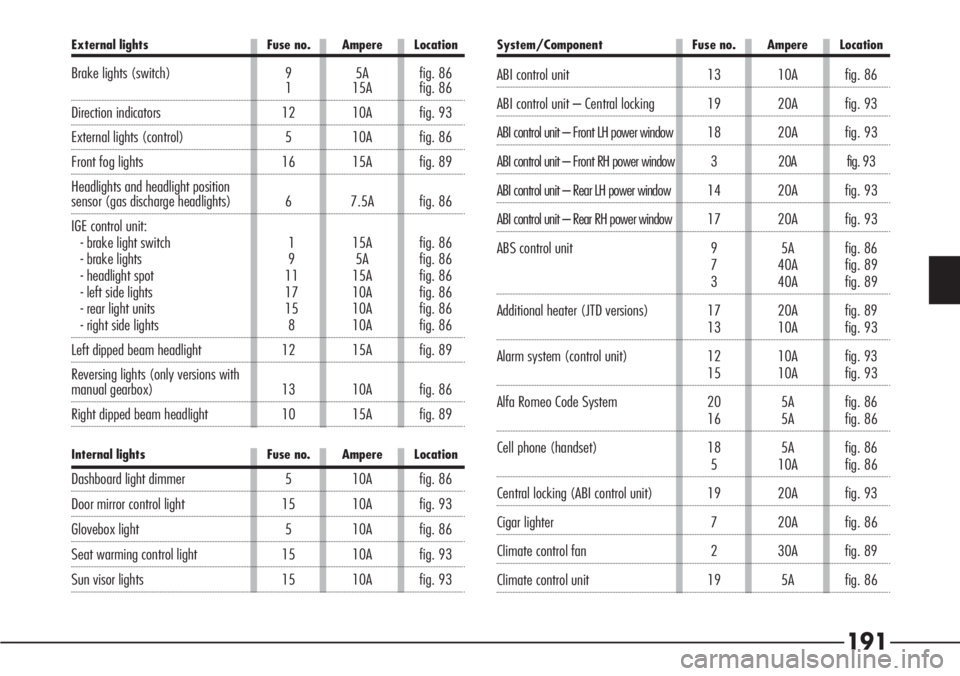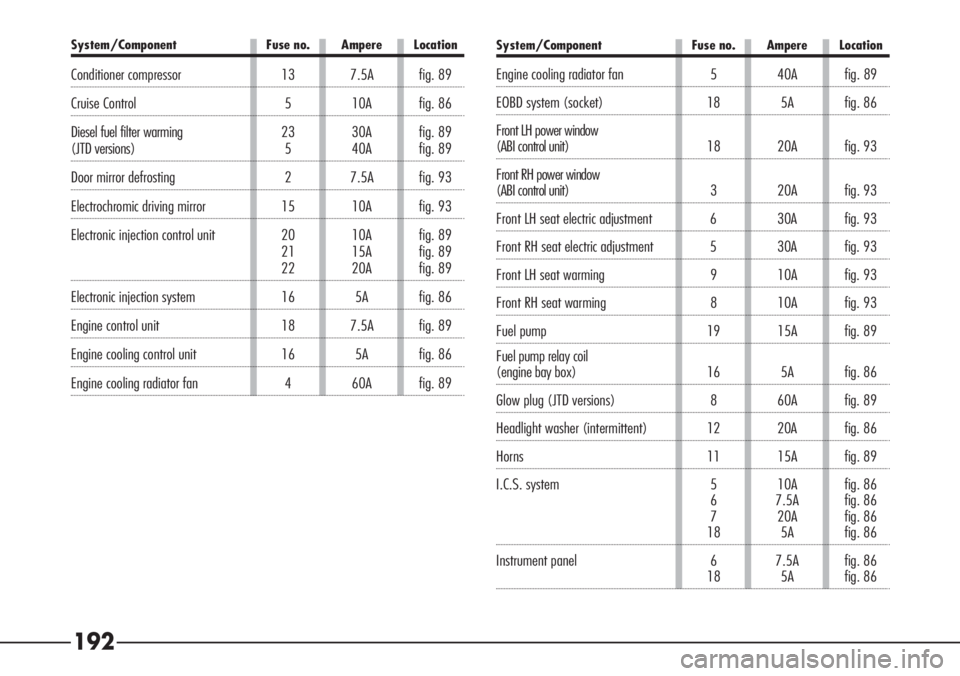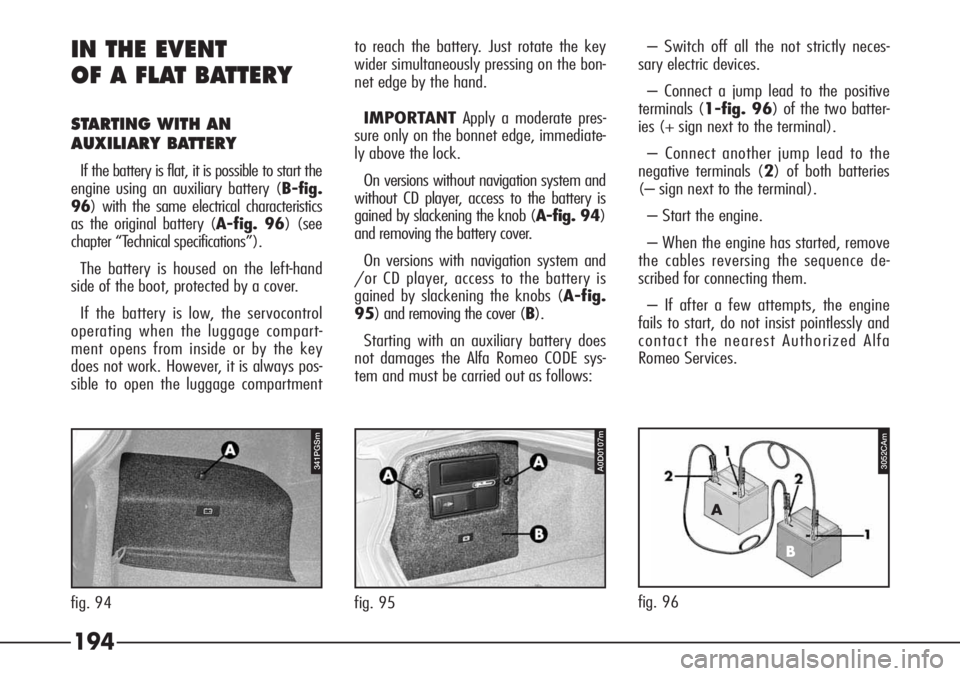Alfa Romeo 166 2006 Owner handbook (in English)
Manufacturer: ALFA ROMEO, Model Year: 2006, Model line: 166, Model: Alfa Romeo 166 2006Pages: 272, PDF Size: 4.17 MB
Page 191 of 272

190
FUSES AND RELAYS IN THE
BOOT
Fuses and relays are housed in the
right-hand side of the boot are housed in
a box, in the recess closed by cover (A-
fig. 92).
To open the cover turn the knob (B).
The devices protected by the fuses in
the boot are listed in the tables on next
pages.IMPORTANTThe arrangement of the
relays may vary depending on the ver-
sions and markets. In the event of a sus-
pected anomaly, contact Alfa Romeo Au-
thorized Services.Circuits operated by relays are the fol-
lowing (fig. 93):
A.Air mixing actuator, climate control
unit, additional heater control (JTD ver-
sions)
B.Rearscreen heating relay
C.Seat warming control, elec-
trochromic driving mirror, sun visor light,
rain sensor, parking sensor control unit,
door mirror control light, remote control
receiver, alarm system control unit, dri-
ver's power window control LOCK warn-
ing light
D.Windscreen heating, door mirror de-
frosting
E.Front seat warming, rear current
socket, front seat electric adjustment,
powered sunroof
F.Direction indicators, trailer presetting
518PGS
fig. 93
A0D0097m
A0D0111m
fig. 92
Page 192 of 272

191
System/Component Fuse no. Ampere Location
ABI control unit 13 10A fig. 86
ABI control unit – Central locking 19 20A fig. 93
ABI control unit – Front LH power window 18 20Afig. 93
ABI control unit – Front RH power window 3 20A fig. 93
ABI control unit – Rear LH power window 14 20Afig. 93
ABI control unit – Rear RH power window 17 20Afig. 93
ABS control unit 9 5A fig. 86
7 40A fig. 89
3 40A fig. 89
Additional heater (JTD versions) 17 20A fig. 89
13 10A fig. 93
Alarm system (control unit) 12 10A fig. 93
15 10A fig. 93
Alfa Romeo Code System 20 5A fig. 86
16 5A fig. 86
Cell phone (handset) 18 5A fig. 86
5 10A fig. 86
Central locking (ABI control unit) 19 20A fig. 93
Cigar lighter 7 20A fig. 86
Climate control fan 2 30A fig. 89
Climate control unit 19 5A fig. 86
External lights Fuse no. Ampere Location
Brake lights (switch) 9 5A fig. 861 15A fig. 86
Direction indicators 12 10A fig. 93
External lights (control) 5 10A fig. 86
Front fog lights 16 15A fig. 89
Headlights and headlight position
sensor (gas discharge headlights) 6 7.5A fig. 86
IGE control unit:
- brake light switch 1 15A fig. 86
- brake lights 9 5A fig. 86
- headlight spot 11 15A fig. 86
- left side lights 17 10A fig. 86
- rear light units 15 10A fig. 86
- right side lights 8 10A fig. 86
Left dipped beam headlight 12 15A fig. 89
Reversing lights (only versions with
manual gearbox) 13 10A fig. 86
Right dipped beam headlight 10 15A fig. 89
Internal lights Fuse no. Ampere Location
Dashboard light dimmer 5 10A fig. 86
Door mirror control light 15 10A fig. 93
Glovebox light 5 10A fig. 86
Seat warming control light 15 10A fig. 93
Sun visor lights 15 10A fig. 93
Page 193 of 272

192
System/Component Fuse no. Ampere Location
Conditioner compressor 13 7.5A fig. 89
Cruise Control 5 10A fig. 86
Diesel fuel filter warming 23 30Afig. 89
(JTD versions) 5 40Afig. 89
Door mirror defrosting 2 7.5A fig. 93
Electrochromic driving mirror 15 10A fig. 93
Electronic injection control unit 20 10A fig. 89
21 15A fig. 89
22 20A fig. 89
Electronic injection system 16 5A fig. 86
Engine control unit 18 7.5A fig. 89
Engine cooling control unit 16 5A fig. 86
Engine cooling radiator fan 4 60A fig. 89
System/Component Fuse no. Ampere Location
Engine cooling radiator fan 5 40A fig. 89
EOBD system (socket) 18 5A fig. 86
Front LH power window
(ABI control unit) 18 20Afig. 93
Front RH power window
(ABI control unit) 3 20Afig. 93
Front LH seat electric adjustment 6 30A fig. 93
Front RH seat electric adjustment 5 30A fig. 93
Front LH seat warming 9 10A fig. 93
Front RH seat warming 8 10A fig. 93
Fuel pump 19 15A fig. 89
Fuel pump relay coil
(engine bay box) 16 5Afig. 86
Glow plug (JTD versions) 8 60A fig. 89
Headlight washer (intermittent) 12 20A fig. 86
Horns 11 15A fig. 89
I.C.S. system 5 10A fig. 86
6 7.5A fig. 86
7 20A fig. 86
18 5A fig. 86
Instrument panel 6 7.5A fig. 86
18 5A fig. 86
Page 194 of 272

193
System/Component Fuse no. Ampere Location
Rearscreen heating 1 30A fig. 93
Relay coil T21, T22, T23 (boot box) 3 5A fig. 86
Relay coil T24 (boot box) 5 10A fig. 86
Remote control receiver 15 10A fig. 93
Sound amplifier 20 25A fig. 93
Sound system 4 15A fig. 86
Sound system controls on steering wheel 5 10Afig. 86
Starter motor 1 30A fig. 89
Trailer presetting 12 10A fig. 93
Windscreen heating 7 15A fig. 93
Windscreen wiper 14 25A fig. 86
System/Component Fuse no. Ampere Location
Navigator 18 5A fig. 86
Parking sensors (control unit) 15 10A fig. 93
Power windows (driver's control
LOCK warning light) 15 10A fig. 93
Powered sunroof 10 20A fig. 93
Presetting 4 – fig. 93
11 – fig. 93
Rain sensor 15 10A fig. 93
Rear current socket 16 20A fig. 93
Rear LH power window (ABI control unit) 14 20Afig. 93
Rear RH power window (ABI control unit) 17 20Afig. 93
Page 195 of 272

194 IN THE EVENT
OF A FLAT BATTERY
STARTING WITH AN
AUXILIARY BATTERY
If the battery is flat, it is possible to start the
engine using an auxiliary battery (B-fig.
96) with the same electrical characteristics
as the original battery (A-fig. 96) (see
chapter “Technical specifications”).
The battery is housed on the left-hand
side of the boot, protected by a cover.
If the battery is low, the servocontrol
operating when the luggage compart-
ment opens from inside or by the key
does not work. However, it is always pos-
sible to open the luggage compartmentto reach the battery. Just rotate the key
wider simultaneously pressing on the bon-
net edge by the hand.
IMPORTANTApply a moderate pres-
sure only on the bonnet edge, immediate-
ly above the lock.
On versions without navigation system and
without CD player, access to the battery is
gained by slackening the knob (A-fig. 94)
and removing the battery cover.
On versions with navigation system and
/or CD player, access to the battery is
gained by slackening the knobs (A-fig.
95) and removing the cover (B).
Starting with an auxiliary battery does
not damages the Alfa Romeo CODE sys-
tem and must be carried out as follows:– Switch off all the not strictly neces-
sary electric devices.
– Connect a jump lead to the positive
terminals (1-fig. 96) of the two batter-
ies (+ sign next to the terminal).
– Connect another jump lead to the
negative terminals (2) of both batteries
(– sign next to the terminal).
– Start the engine.
– When the engine has started, remove
the cables reversing the sequence de-
scribed for connecting them.
– If after a few attempts, the engine
fails to start, do not insist pointlessly and
contact the nearest Authorized Alfa
Romeo Services.
fig. 96
A
B
fig. 94
A0D0107m3052CAm
fig. 95
341PGSm
Page 196 of 272

195
To avoid damaging the
vehicle’s electrical sys-
tem follow the manu-
facturer’s system instructions ac-
companying the jump leads. The
jump leads must be of a suffi-
cient cross-section and long
enough to ensure that the two
vehicles do not touch.
Never use a quick bat-
tery charger to start
the engine in an emer-
gency as this could damage the
electronic systems of your vehi-
cle, particularly the control units
which manage the starting and
supply functions.
The battery terminal
connecting and discon-
necting operations gen-
erate current that may cause
problems to the car’s electronic
systems. Therefore, this opera-
tion should be carried out by
skilled personnel.
At the end of the operation refit the bat-
tery cover.
IMPORTANT If the battery was com-
pletely drained, it may be necessary to
carry out the Alfa Romeo I.C.S. “self-
teaching” operation as follows:
– Let the engine idle to allow the bat-
tery to recharge and make sure it will
start next time.
– Switch the engine off.
– Turn the ignition key to MARand
leave it in this position for 30 seconds to
1 minute, then turn it to STOPfor about
5 to 10 seconds, after which the engine
can be started.
This starting procedure
must be carried out by
qualified personnel as incorrect op-
erations may provoke electrical
discharge of great intensity. The
liquid contained in the battery is
toxic and corrosive. Avoid contact
with skin and eyes.
Keep naked flame, and lighted cig-
arettes away from the battery. Do
not cause sparks.
WARNING
Page 197 of 272

196 IF THE VEHICLE
IS TO BE TOWED
Towing the vehicle (fig. 97)
The rings for towing the vehicle are
housed in the right and left lower part of
the underbody.
Towing another vehicle
(fig. 98-99)
The tow ring supplied with the vehicle is
housed in the tool container under the
boot mat.To install the tow ring, proceed as fol-
lows:
– Take the tow ring from the tool con-
tainer.
– Remove the cover (A-fig. 98) s-
nap-fitted on the rear bumper as follows:
Take the screwdriver from the tool con-
tainer in the boot, under the trim.Using the flat bladed side protected with
a soft cloth, insert the screwdriver on the
upper part of the cap and press gently to
prise the catch from its housing.
– Firmly screw the ring (B-fig. 99) in
its housing.
Make sure that the tow
ring is firmly tightened (it
must be turned about 8 times in its
threaded housing); carefully clean
the threaded housing before tight-
ening the ring.
WARNING
448PGS
fig. 97
A0D0089mA0D0088m
fig. 98 fig. 99
A0D0090m
Page 198 of 272

197 IF THE VEHICLE
IS TO BE LIFTED
USING THE JACK
See paragraph “In the event of a punc-
ture” of this chapter.
You are informed that.
– the jack mass is 2.100 kg;
– the jack requires no adjustment;
– the jack cannot be repaired and in
case of breakage it must be replaced by
another original one.
– no tool other than its cranking lever
may be installed on the jack.
Before beginning to tow
the car, turn the ignition
key to MAR and then to STOP, do
not remove it. Removing the key
automatically engages the steering
lock resulting in the impossibility
to steer the wheels. When towing
remember that without the help of
the servobrake and power steer-
ing, it is necessary to exert more
effort on the brake pedal and for
steering. Do not use flexible cables
for towing and avoid jerks. During
towing operations make sure that
fastening the joint to the car does
not damage the components in
contact with it. When towing the
car it is compulsory to comply with
the specific traffic regulations con-
cerning both the towing device and
behaviour on the road.
WARNING
The car may fall if the
jack is not positioned cor-
rectly. Never use the jack for
higher capacities than the one
stated on its label.
The purpose of the jack is
only for replacing wheels
on the car with which it is provided
or on cars of the same model. It
must never be used for other pur-
poses such as for example raising
cars of other models. In no case
must it be used for repairs under
the car.
WARNING
WARNING
Page 199 of 272

198IN THE EVENT
OF AN ACCIDENT
– It is important to keep calm.
– If you are not directly involved, stop
at a distance of at least ten metres from
the accident.
– On the motorway stop without ob-
structing the emergency lane.
– Turn off the engine and switch on the
hazard warning lights.
– At night, light the place of the acci-
dent with your headlights.
– Take care not to put yourself in dan-
ger of being run over.
– Signal the accident placing the reflect-
ing triangle plainly in view at the regula-
tion distance.
– Call the rescue organisation giving in-
formation as exact as possible. On motor-
ways use the special call boxes.
– In motorway pileups, especially with
poor visibility, the risk exists of being in-
volved in other crashes. Leave the vehi-
cle immediately and go over the guard
rail. The car is to be lifted
positioning the jack or
the workshop lift arm
plate only in the points shown
(1-2 fig. 100).
Between the lift plate and the
body interpose a rubber pad
with a maximum size of 60x60
mm and maximum thickness of
30 mm. The pad should insert in
the special recess on the under
door panel, without interfering
with it.
USING AN ARM LIFT OR
WORKSHOP LIFT
The vehicle must only be lifted laterally
positioning the ends of the arms or the
workshop lift in the areas (1-2) illustrat-
ed, approx. 30 cm from the profile of the
wheelhouse (fig. 100).
A0D0040m
fig. 100
Page 200 of 272

199
– If the doors are blocked, do not try to
get out of the car breaking the wind-
screen which is stratified. The windows
and rearscreen can easily be broken.
– Remove the ignition key from the ve-
hicles involved.
– If you smell fuel or other chemical
products, do not smoke and stub ciga-
rettes.
– To put our even small fires use the ex-
tinguisher, blankets, sand, earth. Never
use water.IF THERE ARE INJURED
PERSONS
– Never abandon an injured person.
Persons not directly involved in an acci-
dent are obliged to give their help.
– Do not crowd around injured people.
– Reassure an injured person that help
is on the way, stay near to cope with any
panic.
– Release or cut the seat belts of in-
jured persons.
– Do not give injured persons to drink.
– An injured person should never be
moved, except in the cases listed below.
– Remove an injured person from the
vehicle only in danger of fire, sinking or
falling.
– When removing an injured person: do
not pull the limbs or bend the head and
keep the body as horizontal as possible.
FIRST AID KIT
In addition to the first-aid kit, it is also
wise to keep an extinguisher and a blan-
ket in the car.